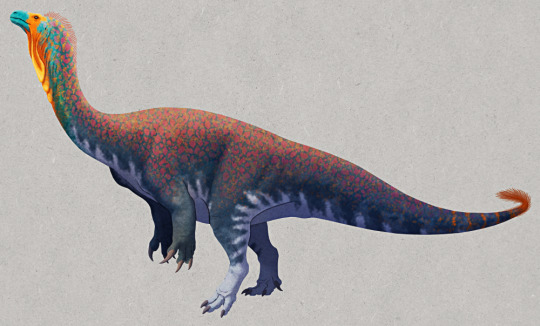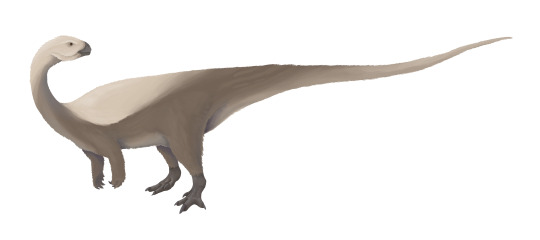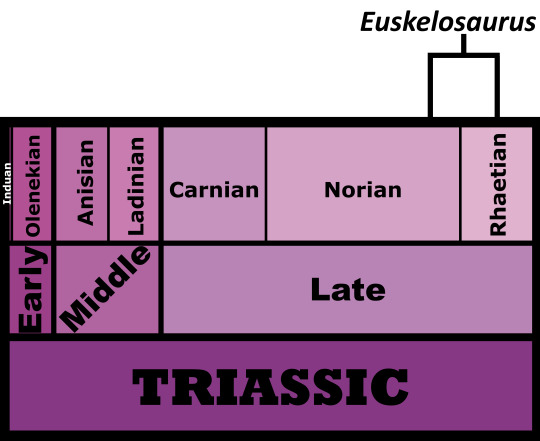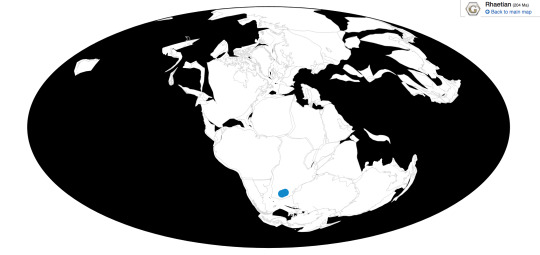#Euskelosaurus
Text
It Came From The Trash Heap (We Don't Talk About Kholumolumo)
A wastebasket taxon is what happens when species can't be easily classified and instead get hurled into a "catch-all" category.
…But that's not the only kind of taxonomic tangle that can befall a new discovery.
When a scientific name is assigned to a new species, but it isn't given a corresponding formal description and type specimen, it becomes a nomen nudum – a "naked name". Without a proper description and assigned holotype the name isn't valid, and the new species isn't technically accepted by the wider scientific community.
This has even happened to some surprisingly famous names. In the 1920s Velociraptor mongoliensis was briefly given the nomen nudum "Ovoraptor djadochtari" before getting its much more familiar name when it was officially described. Meanwhile the giant pterosaur Quetzalcoatlus northropi was stuck as a nomen nudum for decades, only finally getting a proper published description in 2021.
And there's another particular long-standing nomen nudum that became mildly infamous – "Thotobolosaurus", the "trash heap lizard".

Discovered next to a literal trash pile in the village of Maphutseng in Lesotho, a few scattered and broken bones of this "prosauropod" sauropodomorph dinosaur were first found in 1930. But it wasn't until the mid-1950s that a more extensive bonebed began to be unearthed at the site, and over the next decade over 1000 fossil fragments were collected.
In the mid-1960s the remains were initially classified as belonging to Euskelosaurus browni (which is now considered to be a wastebasket taxon), but just a few years later in 1970 the "Maphutseng Beast" was re-evaluated as a species new to science. It was referred to as "Thotobolosaurus mabeatae" – based on the local name of the discovery site, "Thotobolo ea ‘Ma-Beata" (trash heap of Beata’s mother) – but this name was never actually formally published.
Despite "Thotobolosaurus" being an undescribed nomen nudum it nonetheless went on to be repeatedly referenced in scientific literature over the next few decades, and appeared in several popular dinosaur books (even as recently as 2020!).
In the mid-1990s it was alternatively named "Kholumolumosaurus ellenbergerorum" in a Ph.D. dissertation, with this name derived from the kholumolumo, a reptilian creature in Sotho mythology, and the Ellenberger brothers who worked on the site. But this also didn't count as a formal publication and instead became a second nomen nudum for the species.
Eventually, 90 years after the first bones were found and 50 years after the debut of the name "Thotobolosaurus", this long-neglected sauropodomorph was finally given a proper published full anatomical description in 2020.
And it also got a third name, this time officially valid, based on the second one from the 1990s: Kholumolumo ellenbergerorum.
For something associated with trash for so long, Kholumolumo is actually now one of the most completely-known prosauropods. At least five different individuals were present in the collected fossil material, possibly as many as ten, and between them most of the full skeleton is represented – with the exception of the skulls, which are only known from a couple of small fragments.
We now know Kholumolumo was rather heavily-built, with chunky limb bones and unusually short shinbones. It would have been one of the biggest animals around in the Late Triassic (~210 million years ago), measuring at least 9m long (~30') and weighing around 1.7 tonnes (1.9 US tons), but despite its size it seems to have still been bipedal.
Due to the highly disarticulated nature of the bones the fossil site may have been a "bone accumulation area", a place where dismembered bits and pieces of different carcasses were regularly carried to be eaten by a predator or scavenger – essentially a trash heap, fittingly enough. A couple of "rauisuchian" teeth have actually been found among the remains, which might indicate what was chomping on these particular Kholumolumo.
———
Nix Illustration | Tumblr | Twitter | Patreon
#it came from the wastebasket#nomen nudum#taxonomy#kholumolumo#thotobolosaurus#prosauropod#massopoda#sauropodomorpha#dinosaur#paleontology#art#science illustration#paleoart#palaeoblr
290 notes
·
View notes
Text
Prosauropods sure know how to party!
#remember when we all had to draw these for adad because that was a trip#dinosaurs#palaeoblr#prosauropods#plateosaurus#sauropods#massospondylus#mussaurus#anchisaurus#eoraptor
65 notes
·
View notes
Photo

Dinosaur sketches
Thats about it
#dinosaurs#ceratosaurus#euskelosaurus#deinocheirus#lurdusaurus#gastonia#latenivenatrix#cryolophosaurus#psittacosaurus#sketches#mesozoic animals#prehistoric animals
32 notes
·
View notes
Photo

THEME: DINOSAURS | FOSSILS
MESOZOIC MIDDLE LIFE ERA FOSSILS | HERBIVORES (plant-eaters) | CARNIVORES (meat-eaters) | OMNIVORES (eater of everything)
This is a list of dinosaurs whose remains have been recovered from africa. Africa has a rich fossil record, but it is patchy and incomplete. It is rich in triassic and early jurassic dinosaurs. African dinosaurs from these time periods include coelophysis, dracovenator, melanorosaurus, massospondylus, euskelosaurus, heterodontosaurus, abrictosaurus, and lesothosaurus. In the middle jurassic, the sauropods atlasaurus, chebsaurus, jobaria, and spinophorosaurus, flourished, as well as the theropod afrovenator. The late jurassic is well represented in africa, mainly thanks to the spectacular tendaguru formation. Veterupristisaurus, ostafrikasaurus, elaphrosaurus, giraffatitan, dicraeosaurus, janenschia, tornieria, tendaguria, kentrosaurus, and dysalotosaurus are among the dinosaurs whose remains have been recovered from tendaguru.
facebook.com/pg/IPlanetsAcademy/photos/?tab=album&album_id=2073991599574710
iPlanets Academy Pre-K Kindergarten Childcare Hybrid Homeschool Summer Camp Overnights Vacations Weekends Date Nights Mom's Day Out Shelter Foster Care
We are open 24 Hours to serve our families!
http://iPlanetsAcademy.com/
https://Facebook.com/iPlanetsAcademy
https://www.linkedin.com/in/iPlanetsAcademy
https://www.Twitter.com/iPlanetsAcademy
https://www.Pinterest.com/iPlanetsAcademy
#MimiRoss
#iPlanetsAcademy
#ChildCareNearMe
#DayCareNearMe
#PreKNearMe
#TuitionBasedPreK
#FamilyChildCare
#FamilyDayCare
#HomeChildCare
#HomeDayCare
#ChildCare
#Daycare
#DaycareTeacher
#ChildCareTeacher
#Homeschool
#HybridHomeschool
#HomeschoolPreschool
#HomeschoolMama
#HomeschoolMom
#Homeschoolers
#HomeschoolCoop
#HomeschoolTeacher
#HomeschoolCurriculum
#HomeschoolClasses
#SummerCamp
#OvernightCare
#WeekendCare
#Vacations
#MomDayOut
#DateNight
#PreschoolAtHome
#Preschool
#PreK
#PreKTeacher
#Kindergarten
#KindergartenTeacher
#FirstGrade
#FirstGradeTeacher
#1stgrade
#SecondGrade
#SecondGradeTeacher
#2ndGrade
#ThirdGrade
#ThirdGradeTeacher
#3rdGrade
#FourthGrade
#FourthGradeTeacher
#4thGrade
#FifthGrade
#FifthGradeTeacher
#5thGrade.
0 notes
Photo

A #euskelosaurus curling up with a snack / #treestar for prompt 3 of #dinovember #dinovember2017 #drawdinovember #illustrator #adobe #adobeillustrator #vector #practice http://ift.tt/2hik4Nf
0 notes
Text
Eucnemesaurus
Eucnemesaurus (/juːkˌniːmᵻˈsɔːrəs/; meaning "good tibia lizard", for its robust tibiae) is a basal sauropodomorph dinosaur genus usually considered to be a synonym of Euskelosaurus. Recent study by Yates (2006), however, indicates that it is valid and the same animal as putative "giant herrerasaurid" Aliwalia. Eucnemesaurus was named in 1920 by Egbert Cornelis Nicolaas van Hoepen. The type species is Eucnemesaurus fortis. The specific name means "strong" in Latin. It is based on holotype TrM 119, a partial skeleton including vertebrae, part of a pubis, a femur, and two tibiae. The remains were found by Van Hoepen in the late Carnian-early Norian-age Upper Triassic Lower Elliot Formation of the Slabberts district, Orange Free State, South Africa. Yates assigned the genus to the new family Riojasauridae, with Riojasaurus, usually regarded as a melanorosaurid.
More details Android, Windows
0 notes
Text
Euskelosaurus browni

By Jack Wood
Etymology: Good Leg Reptile
First Described By: Huxley, 1866
Classification: Dinosauromorpha, Dinosauriformes, Dracohors, Dinosauria, Saurischia, Eusaurischia, Sauropodomorpha, Bagualosauria, Plateosauria, Plateosauridae
Status: Extinct
Time and Place: Around 210 to 205 million years ago, from the Norian to the Rhaetian ages of the Late Triassic


Euskelosaurus is known from the lower Elliot Formation of South Africa

Physical Description: Euskelosaurus would have been a somewhat large, robust early sauropodomorph, possibly ten meters in length. It probably would have had long arms with long claws on the fingers, but they wouldn’t have had long enough arms to reach the ground. Euskelosaurus would have also had robust legs and a long tail. Its neck would have been long, ending in a small head. It might have been covered in some sort of fluffy covering, though we can’t be sure. It probably would have been quite heavy in general.
Diet: Euskelosaurus would have probably been an herbivore, most likely a mid-level browser.
Behavior: It is difficult to say exactly what the behavior of Euskelosaurus would have been, given it’s known from kind of poor remains. However, we can guess some things. Based on relatives like Massospondylus and the dinosaur family tree in general, it probably took care of its young. Based on other prosauropods, it probably lived in herding groups. And, given its size, it probably spent most of its time eating plant food. It also would have been active and warm-blooded, but not very fast. It’s claws could have been used to strip leaves off of branches, and its small head would have been able to weave in between dense foliage.

By Scott Reid
Ecosystem: Euskelosaurus lived in the Elliot Formation, a famous fossil ecosystem of Triassic to Early jurassic age animals showcasing how life evolved around the Triassic-Jurassic extinction and how dinosaurs began to explode into new forms right after the extinction. Unfortunately, Euskelosaurus hails from the early part of that ecosystem - the more poorly known Triassic member, where dinosaurs are few and far between, as are other animals. This makes Euskelosaurus important, being one of few dinosaurs known from this ecosystem, but also explains its poor condition. This was a semi-arid floodplain and lake system, with very long dry seasons and flash-in-the-pan wet seasons. It was primarily filled with conifers, as well as some horsetails and cycads.
It’s difficult to say exactly what animals Euskelosaurus lived with, given that the organization of the formation is murky and there are animals that are actually in the Upper Elliot Formation that were originally said to be in the Lower. However, Euskelosaurus probably lived alongside other Sauropodomorphs, including Eucnemesaurus, Plateosauravus, Blikanasaurus, and maybe others. There would have also been cynodonts, weird crocodile relatives, and even predatory dinosaurs. Until more is sorted out, however, it’s difficult to say.
Other: Euskelosaurus was a prosauropod, a type of dinosaur from which the larger sauropods would evolve at the end of the Triassic. It seems to be closely related to the better known Plateosaurus.
~ By Meig Dickson
Sources under the Cut
Bordy, E.M.; Eriksson, P. (2015-09-01). "LITHOSTRATIGRAPHY OF THE ELLIOT FORMATION (KAROO SUPERGROUP), SOUTH AFRICA". South African Journal of Geology. 118 (3): 311–316.
Broom, R. (1911). "On the dinosaurs of the Stormberg, South Africa". Annals of the South African Museum. 7: 291–308.
Cooper, M.R. (1980). "The first record of the prosauropod dinosaur Euskelosaurus from Zimbabwe". Arnoldia Zimbabwe. 9 (3): 1–17.
Durand, J.F. (2001). "The oldest juvenile dinosaurs from Africa". Journal of African Earth Sciences. 33 (3–4): 597–603.
Galton, Peter M. (1985). "Notes on the Melanorosauridae, a family of large Prosauropod Dinosaurs (Saurischia: Sauropodomorpha)". Geobios. 18 (5): 671–676.
Gauffre, Francois-Xavier (1993). "Biochronostratigraphy of the Lower Elliot Formation, southern Africa) and preliminary results on the Maphutseng dinosaur. Saurischia: Prosauropoda) from the same Formation of Lesotho". In Lucas, Spencer G.; Morales, Michael (eds.). The Nonmarine Triassic: Bulletin 3. pp. 147–9.
Huxley, TH (1866). "On the remains of large dinosaurian reptiles from the Stormberg mountains, South Africa". Geological Magazine. 3: 563–4.
McPhee, Blair Wayne (2016). The South African Mesozoic: advances in our understanding of the evolution, palaeobiogeography, and palaeoecology of sauropodomorph dinosaurs (Thesis).
McPhee, Blair W.; Choiniere, Jonah N. (2016). "A hyper-robust sauropodomorph dinosaur ilium from the Upper Triassic–Lower Jurassic Elliot Formation of South Africa: Implications for the functional diversity of basal Sauropodomorpha". Journal of African Earth Sciences. 123: 177–184.
McPhee, B. W., E. M. Bordy, L. Sciscio, J. N. Choiniere. 2017. The sauropodomorph biostratigraphy of the Elliot Formation of Southern Africa: Tracking the evolution of Sauropodomorpha across the Triassic-Jurassic boundary. Acta Palaeontologica Polonica 62 (3): 441 - 465.
Sciscio, Lara; De Kock, Michiel; Bordy, Emese; Knoll, Fabien (2017-11-01). "Magnetostratigraphy across the Triassic-Jurassic boundary in the main Karoo Basin". Gondwana Research. 51: 177–192.
Seeley, H.G. (1894). "XLI.—On Euskelesaurus Brownii (Huxley)". Annals and Magazine of Natural History. 14 (83): 317–340.
Tankard, Anthony; Welsink, Herman; Aukes, Peter; Newton, Robert; Stettler, Edgar (2009-09-01). "Tectonic evolution of the Cape and Karoo basins of South Africa". Marine and Petroleum Geology. 26 (8): 1379–1412.
Van Heerden, J. (1979). The morphology and taxonomy of Euskelosaurus (Reptilia: Saurischia: Late Triassic) from South Africa. Nasionale Museum.
Welman, Johann (1999). "The basicranium of a basal prosauropod from the Euskelosaurus range zone and thoughts on the origin of dinosaurs". Journal of African Earth Sciences. 29 (1): 227–232.
Yates, A.M. (2004). The death of a dinosaur: dismembering Euskelosaurus. Geoscience Africa. p. 715.
#Euskelosaurus#Euskelosaurus browni#Prosauropod#Dinosaur#Sauropodomorph#Palaeoblr#Factfile#Dinosaurs#Triassic#Africa#Herbivore#Mesozoic Monday#paleontology#prehistory#prehistoric life#biology#a dinosaur a day#a-dinosaur-a-day#dinosaur of the day#dinosaur-of-the-day#science#nature
184 notes
·
View notes
Photo

Plateosauravus
Plateosauravus ("grandfather of Plateosaurus") is a basal sauropodomorph of uncertain affinities from the late Triassic of South Africa. Sidney Haughton named Plateosaurus cullingworthi in 1924 from a partial skeleton, type specimen SAM 3341, 3345, 3347, 3350-51, 3603, 3607. The specific name honoured collector T.L. Cullingworth. Friedrich von Huene reassessed it in 1932 as belonging to a new genus, that he named Plateosauravus. Jacques van Heerden reassigned it to Euskelosaurus in 1976, and this has been how it was usually considered. However, recent study indicates that Euskelosaurus is based on undiagnostic material and thus a nomen dubium; in his series of sauropodomorph and basal sauropod papers, Adam Yates has recommended no longer using Euskelosaurus and has suggested the use of Plateosauravus instead for what is normally thought of as Euskelosaurus. More than a dozen additional partial skeletons have been found in the Kruger National Park after a discovery by game warden Adriaan Louw on 27 March 1995. These include juvenile individuals←(Durand,2001).
More details Android, Windows
0 notes
Text
Euskelosaurus browni

Source: thewoodparable (Let’s all give him a hand for helping with Prosauropod Hell 2015!! What a trooper.)
Name: Euskelosaurus browni
Name Meaning: Good Leg Lizard
First Described: 1866
Described By: Huxley
Classification: Dinosauria, Saurischia, Eusaurischia, Sauorpodmorpha, Plateosauria, Plateosauridae
Euskelosaurus was based on some limb and spinal bones found in the 1800s. As such, it is not particularly well known. It was estimated to be about 10 meters long, and was found in the Lower Elliot Formation of Lesotho and South Africa and the Mpandi Formation of Zimbabwe. It lived in the Norian age of the Late Triassic, somewhere between 228 and 208 million years ago. It was an interesting dinosaur in that its thigh bone was twisted; one paleontologist suggested that this made Eusklosaurus bow-legged. If this is right, this is odd, as dinosaurs have their legs directly underneath their bodies.
Sources:
https://en.wikipedia.org/wiki/Euskelosaurus
http://www.prehistoric-wildlife.com/species/e/euskelosaurus.html
Shout out goes to travis3308!
#euskelosaurus#euskelosaurus browni#travis3308#dinosaur#prosauropod#dinosaurs#a dinosaur a day#dinosaur-of-the-day#science#nature#biology#dinosaur of the day#paleontology#prehistory#prehistoric life#factfile
34 notes
·
View notes